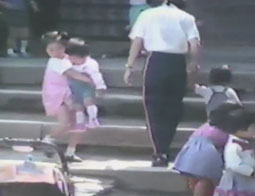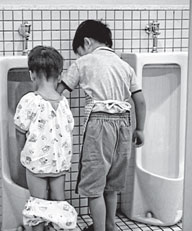I. A Fortuitous Meeting in Shanghai
Last October, I was one of several foreigners invited by Professor Jiaxiong Zhu to give a talk at a conference he organized in Shanghai. Several months earlier, when I agreed to participate, I did not know that the conference theme would be "0-3 Early Childhood Education and Care." When I learned of the conference theme I was a bit worried about what I could talk about because most of my research over the years has focused on programs for children 3-6 years old. Eventually, I came up with the idea of going back to some things I learned forty some years ago as a doctoral student in cultural and human development about who cares for young children. I realized I could then combine this anthropological knowledge with some examples from my research in Japanese hoikuen (daycare centers) of interactions between the older children with infants and toddlers. This paper is the result.
I would add that a great and unexpected pleasure of the Shanghai conference was having opportunities to interact with Dr. Yoichi Sakakihara. We had met before, but never had heard each other give presentations or had the time to have a real conversation. Dr. Sakakihara's talk on what recent developments in neural science can help us understand about connections between children's play and their intellectual and social development sparked my interest and resonated well with my own findings from my ethnographic research in Japanese preschools. Interacting with Dr. Sakakihara was a reminder that the field of ECEC is so rich because it can be a site for making connections between the fields of medicine, developmental psychology, anthropology, sociology, and education. Insights from pediatricians and anthropologists can broaden the field of early childhood education and care's understandings of what is possible and desirable to do with young children.
II. A Note on Terminology
Writing in English about Japanese early childhood education and care is tricky because the Japanese terms used for the different forms of provision do not easily match up with U.S. equivalents. For about a century, Japan has had two main forms of ECEC provision: youchien, which offer part-day programs (usually from about 9 a.m. to 2 p.m.) and serve children from ages 3-6, whose mothers do not have full-time jobs, and hoikuen, which are open from early in the morning until 6 p.m. or so, and serve chidren from 0-6, whose parents have full-time jobs. Recently, following many years of attempts by the government to combine and rationalize the two system, a third firm of provision, the kodomoen, has been added. Kodomoen combine features of hoikuen and youchien, as they are open all day, for infants through six year olds, and offer a mix of early childhood education and care to children from both working class and middle class families. "Youchien" literally means "kindergarten," but I prefer to refer to these programs in English as "preschools" or "nursery schools," because in the U.S. "kindergarten" usually means the first year of primary school. "Hoikuen" I translate into English as "daycare center," the term historically used in the U.S. for programs serving children of working parents offering all-day care for children from infancy through six years old. "Kodomoen," which literally means "children's garden," I translate as "children's center," a term frequently used by programs in the U.S. that serve children of varying social classes and that combine emphases on care and education.
III. Why Children under Aged Three Being Home with Their Mothers All Day Is a Bad Idea.
In many countries, there is controversy and anxiety about children under age 3 being taken care of by anyone other than their parents. Or to put it another way, there is a belief in modern countries that parents should spend as much time as possible with their children when they are under 3, and if they don't this will be deleterious for the child's emotional, social, and cognitive development. I acknowledge that the word "modern" is an awkward and misleading term to use to categorize countries. I use it nevertheless to make the point that the belief that infants and toddlers should be cared for mostly by their mothers is highly correlated with an advanced stage of economic and social development, and indeed is a symptom of what some call the malaise of modernity, or "the post-modern condition." I'm suggesting that once countries reach a certain level of economic development a kind of family structure emerges that emphasizes the nuclear family, heavy economic and emotional investment in young children, intense forms of parenting, and a belief that children under 3 should spend as many of their waking hours as possible in the company of their mother.
In the U.S., many parents, educators and policymakers worry that putting children under age 3 in ECEC programs and taking them away from parental (mostly maternal) care is a dangerous social experiment. But I suggest that the reverse is true: The idea that infants and toddlers should be cared for entirely or mostly by their parents is a recent invention, a radical idea, and daring but perhaps ill-advised social experiment. This is the argument of Edwards and Whiting's 1988 Children of Different Worlds. They made the point that for most of history, in most cultures, most children under 3 have been cared for most of the time by someone other than their mothers and fathers, most often by grandparents and older children.
Agrarian and newly industrializing societies can't afford to have healthy young mothers be out of the work force, so people other than the mother take care of the infants and toddlers. This is usually a mixture of older children and grandparents. But with increased national wealth, societies can afford to have healthy young mothers stop working when they have a baby and be full-time mothers. And in these societies grandparents are likely to still be working and older children in school, which leaves the stay at home young mother without much help or companionship.
Edwards and Whiting contrast the way children under 3 are cared for in countries including Kenya, India, and the U.S. One surprising finding is that the middle-class U.S. mothers who spend all day with their infants and toddlers, inside their house, mostly isolated from contact with other adults, were the most stressed and frustrated. Edwards and Whiting argued that in this arrangement there is a dangerous lack of stimulation not only for the child, but also for the mother, who becomes isolated and grouchy, which in turn is bad for the child.
IV. Mixed-age Education

A video we made in 1985 at Komatsudani Hoikuen in Kyoto shows four- and five-year-old girls carrying toddlers down a short flight of steps and out to the playground. In 1986, when we told Assistant Director Higashino of Komatsudani that Americans who viewed the videos found this practice alarming, she assured us that the older children are careful with the babies and that staff members are always nearby when older children play with younger ones. She emphasized that this activity is especially valuable for the older children, most of whom don't have younger siblings, because it gives them "a chance they might not otherwise have to develop empathy (omoiyari) and to learn how to know and anticipate the needs of another (ki ga tsuku)" (1989, p. 35).
In 1985, older children playing with and caring for babies was a practice the administrators and teachers supported, but did not orchestrate. In 2000, Nogami-sensei, the teacher of the oki-gumi class of five year olds, decided to formalize mixed-age interactions by having the older children take turns as helpers (toban) in the infant and toddler rooms. A system was worked out in which each day four children from the five-year-old class would spend half an hour downstairs, with the zero- to two-year-olds during afternoon snack time. The older children not only played with the younger ones, but also learned to care for them. They helped the little ones change clothes, eat, play, and even to use the bathroom.
Komatsudani's toban approach to mixed-aged interactions was not found in most other Japanese child care facilities at the time. This scheduled practice of having the older children be toban for the infants and toddlers only lasted at Komatsudani for two years, before they returned to their previous informal practice of having babies and older children mix spontaneously during periods of the day. While the formal practice of daily mixed age interaction between older and younger children may have been rare in hoikuen, the logic behind the practice was widely endorsed by Japanese early childhood education experts and by the teachers and directors of other Japanese preschools we have shown the Komatsudani videos and interviewed.
Because youchien have no children under the age of 3, they cannot provide the opportunities hoikuen can for older children to interact with infants and toddlers. But many youchien staff members who have watched our Komatsudani video told us that they encourage spontaneous interactions between older and younger children and that they have instituted systematic interactions between older and younger classes (as for example, having them collaborate on projects or assigning older children as "older siblings" to younger ones). Hoikuen directors report that their older children often interact spontaneously with their babies and toddlers and that while they had not considered initiating a toban system for mixed-aged interaction prior to seeing our video, it is something they might now consider.
V. Empathy
One of the key findings of the original Preschool in Three Cultures study was that preschools are inherently conservative in that they are relatively new social institutions charged with making sure young children are taught traditional cultural values. Preschools are asked to compensate for experiences of social and emotional complexity children in earlier eras enjoyed in their families and communities but which are disappearing under contemporary social conditions. One of the traditional values that is perceived to be at risk among contemporary Japanese young people is omoiyari, the ability and willingness to understand and respond to the feelings and needs of others.
Komatsudani's innovative practice of having the older children take turns serving as toban for the younger children can be seen as bringing the history of childcare full circle, a return to a very old and enduring human practice which was only recently abandoned. In industrialized societies, older children minding younger ones is becoming a lost art, a vanishing experience, and a forgotten form of knowledge. The innovative child-minding program at Komatsudani can be thought of as a rediscovery of an important form of cultural logic lost in most modern societies.
We see the wisdom of this old logic clearly in a scene we videotaped of a pee lesson and described in our book Preschool in Three Cultures Revisited. There are some tasks of childcare and socialization that five- and six-year-old children can handle not just competently, but better than can adults. Teaching a toddler to pee is one of these tasks. In this scene in our video (Photo below), we see five-year-old Kenichi and to two-year-old Taro standing in front of a urinal and Kenichi says: "Oshikko shinasai" ("Please pee"). Kenichi then gives a series of direct detailed instructions to Taro on how to pee, reminding him to lift up his pajama top, to aim, and to make sure he is done peeing before pulling up his pajama bottoms. Kenichi ends his hands-on lesson with a warning that he is about to flush the urinal.

The understanding and empathy displayed by the older boy in the pee lesson are extraordinary. When Kenichi asks two-year-old Taro, "Did it all come out?" he is perfectly cued in to the younger boy's mind set. When Kenichi pantomimes excitement at the sound of the flush, he is empathizing with the toddler's interest, fear, and excitement at this new experience. The sound of the flush can no longer be exciting, surprising, or scary to five-year-old Kenichi, who we must therefore assume is performing rather than feeling interest, surprise, or fear at the sound of the flush in order to help Taro, for whom flushing is still relatively new, become comfortable with the experience. This is true omoiyari.
In societies such as Japan, where the number of children without siblings have increased, and such as the United States, where the age segregation of children keeps younger and older children apart for most of the day, opportunities for older and younger children to interact are rare, compared to previous eras. In the absence of opportunities for younger children to be taught to urinate by older children, the task falls on adult women to teach boys to use a urinal, a task they generally take on more awkwardly and with less enthusiasm than does Kenichi--you have to have a keen knowledge of and interest in a subject to teach it well.
VI. Unification of Kindergartens and Daycare Centers and Mixed-age Care
In a paper on obstacles to the implementation of the Japanese early childhood education reform titled "Unification of Kindergartens and Daycare Centers") ((youhoichigenka), Yuki Imoto (2007) argued that contemporary Japanese discourses of motherhood and early childhood education can be traced back over a century, and specifically to the 1899 Imperial Ordinance on Elementary Education and Infant Training, whose regulations:
...limited kindergarten classroom time to five hours per day, ensuring that operating hours were too limited to permit the schools to care for children while their parents worked. It thus worked in consonance with the newly introduced concepts espoused by the MoE of ryosai kenbo ('good wife, wise mother') - a Confucian-tainted 'Japanized' rhetoric of the modern Western middle-class ideology of family domesticity, which rendered women as the homemakers marking a gendered division of labour within the family and transferring the responsibilities of childrearing to the mother (p. 92).
Imoto's comment here brings me back to where I began this paper: with the idea that mothers needing be the primary care takers for infants and toddlers is a discourse that arose a little over a century ago, with modernization. In the post-modern era we live in, in Japan as in the U.S. and other economically developed countries, it no longer makes economic or social sense for young women to leave the labor force for several years when they have children. Youchien enrollments have dropped and hoikuen enrollments risen as increasing numbers of parents seek out programs offering full day care.
This leads me to a final thought: Perhaps the gradual policy shift in Japanese early childhood and education toward a unified system of early childhood education and care (youhoichigenka) for children from infancy to six years old will provide increased opportunities for mixed-aged interactions. As mentioned earlier in this paper, youchien, which have traditionally not enrolled children under age 3, have not been able to provide opportunities for four- and five- year old children to interact with infants and toddlers. It's a bit too early to tell how long it will take for this long-planned unification of the two systems to be fully implemented. But as Akiko Hayashi and I argued in a recent paper (2017), many youchien are in the process of enrolling infants and toddlers, and as they do so they are struggling to figure out how to integrate these two kinds of services (hoiku and kyoiku). For now, many youchien seem to be largely keeping apart the children over and under 3, often in different buildings, with different staff working with them. But I see a real possibility here, a hope that as youchien gradually embrace what it means to be a kodomo-en, that staff will realize the opportunity they now have for enhancing tate-wari kyoiku (mixed-age education).
References Cited
- Hayashi, A., & Tobin, J. (2017). Reforming the Japanese preschool system: An ethnographic case study of policy implementation. Education Policy Analysis Archives, 25(101). http://dx.doi.org/10.14507/epaa.25.3213
- Imoto, Y. (2007). The Japanese Preschool System in Transition, Research in Comparative and International Education, 2 (2), 88-101.
- Tobin, J., Hsueh, Y., & Karasawa, M. (2009). Preschool in Three Cultures Revisited: China, Japan, and the United States. Chicago: University of Chicago Press.
- Tobin, J., Wu, D., & Davidson, D. (1989). Preschool in Three Cultures: Japan, China and the United States. New Haven: Yale University Press.
- Whiting, Beatrice, and Carolyn Edwards. 1988. Children Of Different Worlds. Cambridge, MA: Harvard University Press.



 Joseph Tobin
Joseph Tobin










